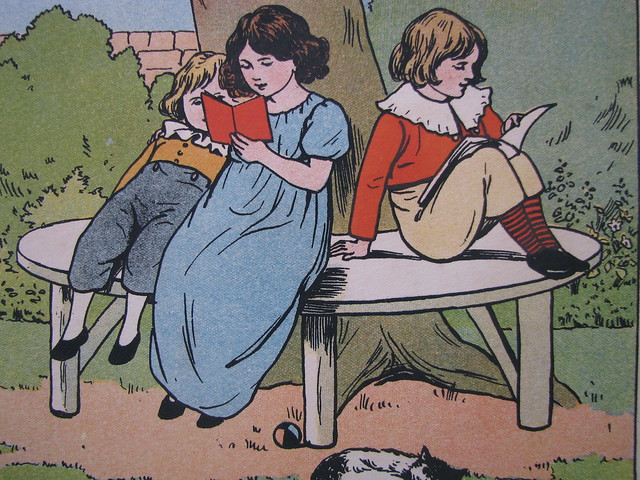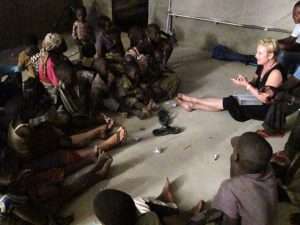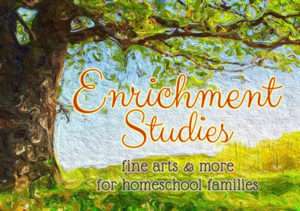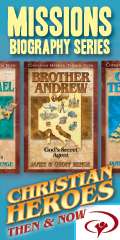I don’t do everything right. There, I admitted it. Ow, that was hard.

I fall short of the ideal in many ways. But I keep goals and ideals in front of me as a target to shoot for. I mess up every day, but I get up the next day and ask forgiveness and start over again with a clean slate.
I believe that Charlotte Mason’s method is one of the best ways to teach children. But I don’t follow her methods strictly. There are other methods that I have developed as the Spirit leads that I believe are more effective with my children. A lot of it depends on their temperament and personality.
And sometimes I don’t follow her methods because I forget them or don’t really understand them, or I’m not as diligent as I should be.
For the sake of my sanity and the peace of my home, I adapt the methods that I believe in and follow them loosely. If I try to be rigid about anything, the fun and enjoyment just disappears for the kids and for me. I get impatient and demanding. These are not fruits of the Spirit.
When it comes to using the Charlotte Mason approach, I don’t follow everything she says to do. (There, I admitted that, too. That didn’t hurt quite as much.)
Narration is one of those things.
Charlotte Mason says it should be done a certain way. From the Charlotte Mason Homeschool Series vol. 1 pg 232
“In every case the reading should be consecutive from a well-chosen book. Before the reading for the day begins, the teacher should talk a little (and get the children to talk) about the last lesson, with a few words about what is to be read, in order that the children may be animated by expectation; but she should beware of explanation and, especially, of forestalling the narrative. Then, she may read two or three pages, enough to include an episode; after that, let her call upon the children to narrate,––in turns, if there be several of them. They not only narrate with spirit and accuracy, but succeed in catching the style of their author. It is not wise to tease them with corrections; they may begin with an endless chain of ‘ands,’ but they soon leave this off, and their narrations become good enough in style and composition to be put in a ‘print book’!
I, personally, don’t require narration of every book I read to them or every book or lesson they read themselves. And I don’t do it the way CM prescribes. My method is less structured and more intuitive. Basically, I have them narrate when the Spirit moves me. It would drive my kids crazy if I stopped every two or three pages and made them narrate. It would spoil our enjoyment of the story.

I found this quote interesting:
From CM Homeschool Series vol. 3 pg 181
“The mind can know nothing but what it can produce in the form of an answer to a question put by the mind to itself.”
Even though I don’t follow her exact methods, I believe that my method is enabling my children to ask the questions themselves instead of forcing them to think about what I’m thinking about.
The narration that happens at my house is more spontaneous and flows from a need or desire that one of us has. For example, if one of my children reads something and then comes and tells me about it because they’re excited and want to share the story with me, I count that as narration.
If I have been reading a story aloud (which is always true) and the next day I want to know where I left off or I want them to get back into it and refresh their memory of what had just happened, I ask them to tell me the last thing we read the day before. And the kids can almost always tell me, in detail, what I read last. They usually tell it quickly, so I’ll hurry and start reading again!
At different times, I ask a child to tell me what he knows about a particular person or topic we’ve been studying. When they answer me, I consider that narration, too.
I use it to find out if they’ve been listening or understanding what we’ve been discussing. Things are found out in this way such as places where their understanding is weak or times that they have not really been paying attention.
I may not be following Charlotte Mason’s method perfectly, but I have seen good fruits in the lives of my children. And I think that’s what matters the most. I think it gives my children a chance to dream and see the images in their own imagination without interruption. I want them to be able to do this:

I read this post by Sally Clarkson where she admitted that she’s not perfect and thought that it fit pretty well with my previous confessions. I hope it encourages you as much as it encouraged me.
Perfect! Not a word high on my vocabulary as an expectation of life












 "Oh that God would give every mother a vision of the glory and splendor of the work that is given to her when a babe is placed in her bosom to be nursed and trained! Could she have but one glimpse in to the future of that life as it reaches on into eternity; could she look into its soul to see its possibilities; could she be made to understand her own personal responsibility for the training of this child, for the development of its life, and for its destiny,--she would see that in all God's world there is no other work so noble and so worthy of her best powers, and she would commit to no other's hands the sacred and holy trust given to her." -JR Miller
"Oh that God would give every mother a vision of the glory and splendor of the work that is given to her when a babe is placed in her bosom to be nursed and trained! Could she have but one glimpse in to the future of that life as it reaches on into eternity; could she look into its soul to see its possibilities; could she be made to understand her own personal responsibility for the training of this child, for the development of its life, and for its destiny,--she would see that in all God's world there is no other work so noble and so worthy of her best powers, and she would commit to no other's hands the sacred and holy trust given to her." -JR Miller







We are just beginning our CM journey. This was interesting to read; I also liked the blog by Sally Clarkson which you linked to, very encouraging!
I agree about not stopping every 2-3 pages, I think my children might get irritated with this also. We typically read a chapter or two and then they FIGHT over who is going to narrate to me first. (they are 4 and 6) We are still young in the CM method, and I admittedly already think some of her stuff is too much. I love her method though!! Thanks for sharing!
[…] Douglas presents Natural Narration: Spontaneous Storytelling posted at Changed By […]
I think your adaptations sound life giving. They are fun, fit to your children and do not interupt learning. Thank you for sharing ways you have adjusted CM’s model in your homeschool, it is inspiring. I wonder if CM would not very much approve of what you are doing…she often revamped things to fit better to real life. Like throwing out books the kids did not enjoy.
I agree with your approach! What I love about Charlotte Mason’s approach is that as my children mature, I can apply new or more CM principles. We are on a journey and Charlotte Mason is one of our strongest guidelines, but the Lord helps us find the “right fit” for our family.
I enjoyed your post. I agree with you, Charlotte Mason’s ideas sometimes can’t be followed exactly but it is the philosophy behind the method that allows us to reap the reward. Each child is different and our approach has to suit their learning style. My humble opinion: you’re doing it right for your needs and family.
The good thing about homeschooling with a method or philosophy (rather than set curriculum) is that it’s much easier to interpret and make your own. I think you are doing a wonderful job applying the method in a way that works for your kids! 🙂
Well said! Ahhhhhhh……